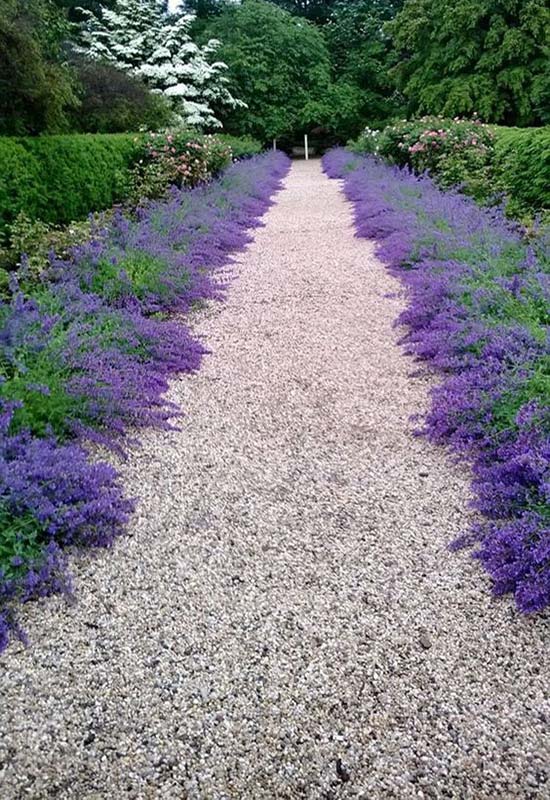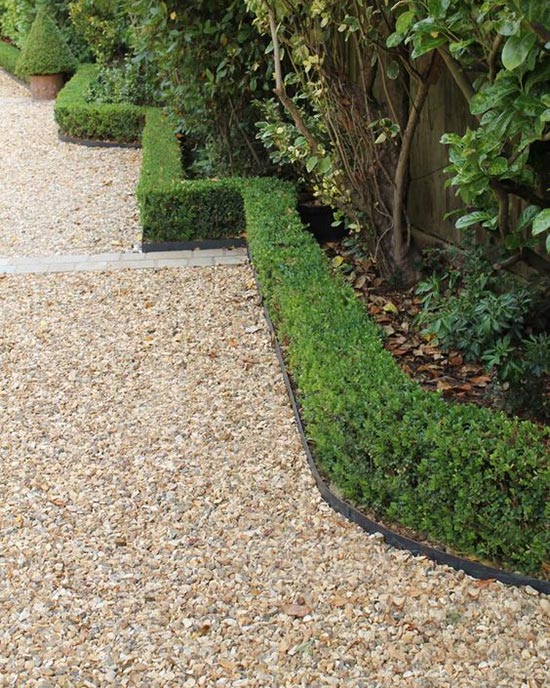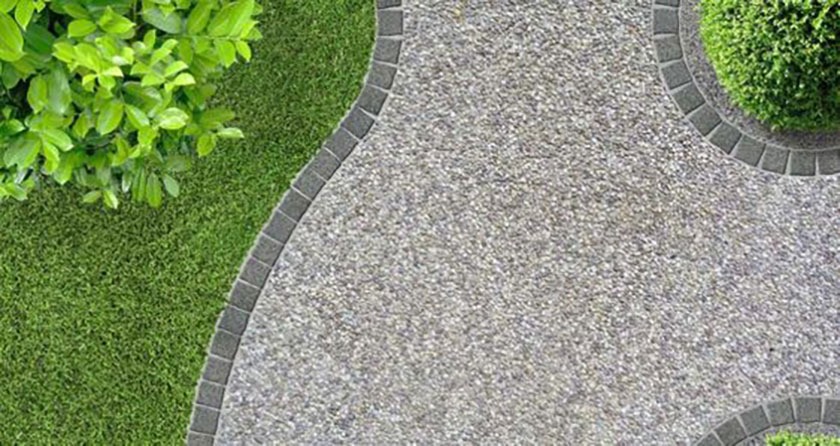
Placing edging along your gravel driveway is an excellent way to contain the driveway material and spruce up your home’s curb appeal. When most people think of gravel driveway edging, they often imagine dull stones along each side, but there are many more options to make your home look just how you want.
Gravel driveways are increasing in popularity and for a good reason. They are very straightforward to install, maintain, and they can last up to 100 years with the proper care. There are also many different ways you can apply edging to a gravel driveway to give your home a unique look that is functional and looks fantastic.
Gravel is a good alternative to a concrete driveway. A gravel driveway can consist of pea gravel, slag rock, or other loose stones. Gravel and other small stones can be a good choice when creating parking areas.
There are many types of edging options. Below, we’ll look at twenty-five of the best ways to edge the sides of your gravel driveway, including vegetation, masonry, wood, and strip edging options.

Best Vegetation Gravel Driveway Edging Ideas
Edging the sides of a gravel driveway with vegetation is a great way to clearly outline the side of the driveway and contain the gravel. It takes more effort to maintain live plants along the sides of your driveway than other alternatives, but the additional curb appeal can be worth it.
1. Flowering Plants
Flowering plants or other decorative garden beds along the edge of the driveway can look beautiful while also acting as effective edging to keep gravel from spilling over the sides. You’ll likely have to put aside time to care for your flowering plants, but choosing ones that grow well in your climate and have a long flowering period can make things easier and is well worth the effort.
2. Hedges
Edging a gravel driveway with hedges gives the space a distinguished look and clearly outlines the path. Depending on the aesthetic you want, you can keep the bushes well-shaped or have them take on a more natural form.
3. Grass
Having grass or lawn come right up the driveway edge is an affordable solution but may require more work to keep the gravel nicely contained. There’s less of a barrier stopping the gravel from washing away when it rains, so it’s important to rake your driveway often and keep the grass edge well-trimmed if you decide to go this route.
Gravel and grass edging work well for a long driveway where edging the entire driveway aren’t practical. You can incorporate post and rail fencing and driveway edging materials as you get closer to the house.
Best Masonry Gravel Driveway Edging Ideas
If you want edging for your gravel driveway that is a bit more permanent and solid, using rock, concrete, brick, and other masonry construction materials is a good choice. While these edging materials tend to be more expensive to install, they last a long time, and you’ll likely never have to replace them based on regular wear and tear.
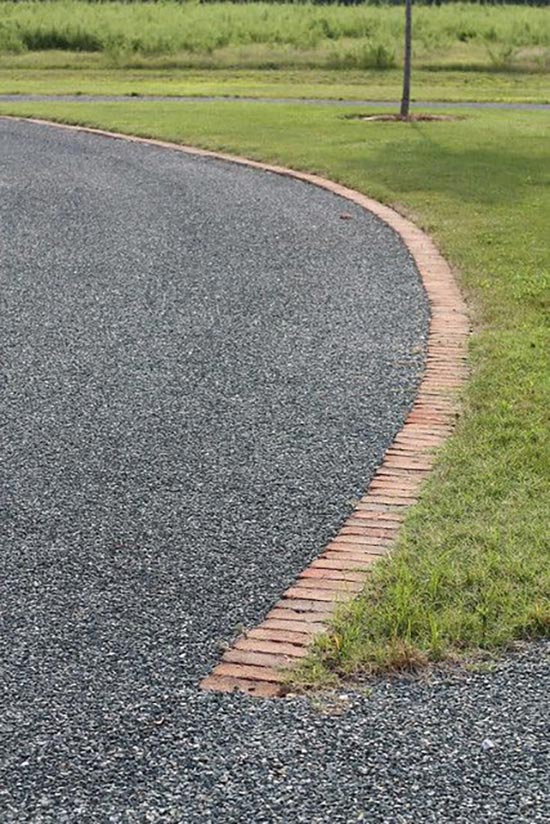
4. Brick Pavers
Using bricks or brick pavers to line the brick edging of your gravel driveway is a budget-conscious choice that also looks excellent. Especially if your home has brick siding, edging your driveway with brick can tie the property together and make it look more cohesive. There are many brick paver design options that you can go with to customize the look further, including lining them vertically or horizontally to the driveway.
5. Concrete Pavers
Concrete pavers are also another excellent option for gravel driveway edging. They clearly define the edges of your driveway while also being very simple and elegant. There are many options regarding concrete paver size and shape, so there is plenty of flexibility to make your driveway look precisely how you want.

6. Flagstones
Using flagstones along the edge of your gravel driveway defines the driveway by creating a broader barrier between it and the yard. Flagstones are often relatively flat and can be expensive, so this probably isn’t the best option for long driveways or places where the ground is somewhat uneven.
7. Limestone Pavers
Limestone is a great gravel driveway edging material as it’s incredibly durable and easy to shape to your needs. It creates a clear boundary to your gravel driveway to keep any loose gravel inside while also adding a classy design element to your property. Most limestones are a shade of white, so it works well with lighter homes or as an accent to darker homes.
8. Cobblestone Pavers
Cobblestone and other stone pavers are one of the most commonly used masonry construction materials for driveway edging. They are highly durable, relatively affordable, and have a timeless look that complements nearly any house design.
9. Sandstone Pavers
Sandstone pavers or rocks are another excellent option for gravel driveway edging. Much like limestone, sandstones are sedimentary rocks often light in color. Using sandstone to edge the sides of your driveway is a practical choice while also providing an earthy and elegant design element to your property.
10. Slate Pavers
Slate pavers or rock are great options for edging a gravel driveway. Slate is generally quite dark in color, adding an elegant feel to your home and driveway. As a metamorphic rock, slate is also incredibly durable, so you won’t have to worry about it breaking down and not doing its job of containing your gravel driveway.
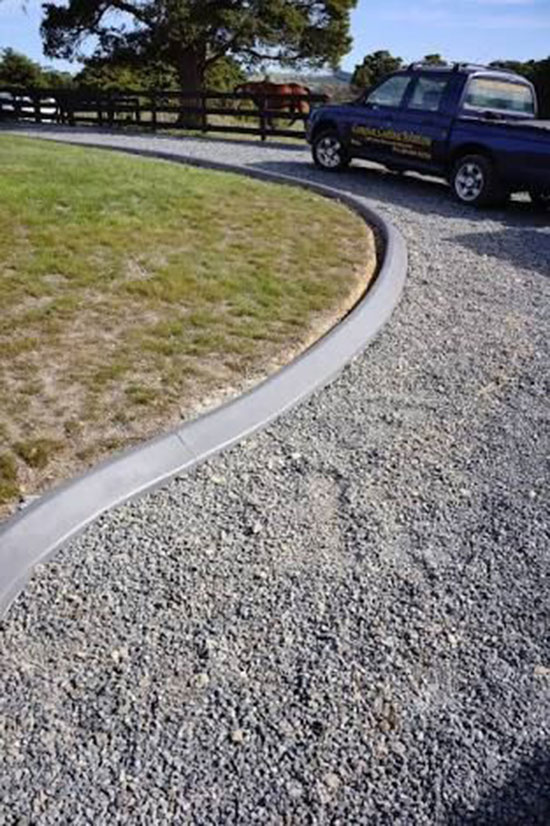
11. Concrete Curb
While quite unconventional for a gravel driveway, concrete curbs can be a unique design option to bring character to your property and stabilize the sides of the driveway. Pouring concrete curbing can be a lot of work and can cost quite a bit, so this option often makes sense if you have a short driveway and the look ties in with the rest of your home.
12. Boulders
The above masonry driveway border options involve finely cut rock or carefully laid concrete, but boulders are an excellent option if you want something more natural. Boulders can complement other landscaping nicely while clearly defining your driveway and keeping loose gravel inside. Sourcing local rock can also tie your property in with the rest of the landscape.
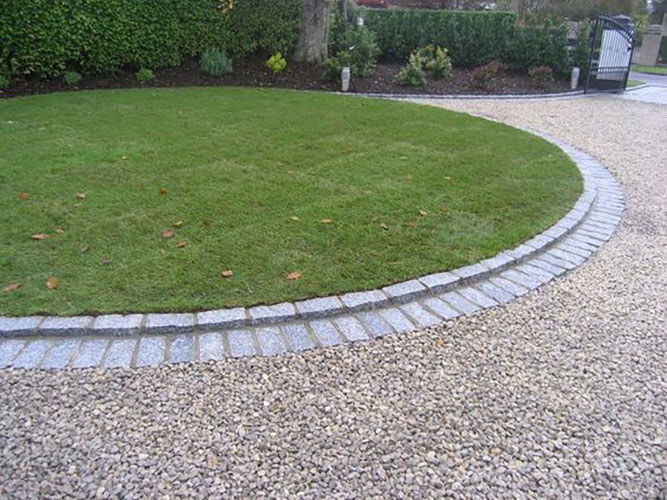
13. Belgian Blocks
Belgian blocks are sizable paving stones typically carved from granite that can make excellent edging material for gravel driveways. They are durable, extremely robust, and add a timeless design element to your property.
You don’t have to worry about shifting or deterioration if you go with Belgian block edging; they will hold up and keep your driveway edges intact for many years.
These look great along a circular drive like pictured above.
14. Pebble Border
Creating a pebble border along the edges of your gravel driveway can be a great design choice to increase curb appeal and help with water drainage. Pebble border driveway edging is versatile because you can change the rocks or pavers outlining the border and the color and size of the pebbles to match your home’s aesthetic.
You can even use a pebble border along a concrete driveway or walkway and transition to an all gravel for a long driveway.
Best Wood Gravel Driveway Edging Ideas
If you’re looking for something more rustic than masonry for your driveway edging, wood edging is an excellent option. There are many types of timber that you can use for the sides of your gravel driveway, ranging from brand new lumber, landscape timbers, and weathered old railroad ties.

15. Railroad Ties
Railroad ties are prevalent as an edging material for gravel driveways, and it’s not by accident. They are relatively easy to install, affordable, good at their job, and highly resistant to insects and weather. Railroad ties also have a rustic, rugged, and industrial look that goes well with many home designs.
16. Local Wood
It’s nearly always a good idea to use local materials on your property whenever possible. Using local wood to edge your gravel driveway is an excellent option to help tie your home into the surrounding environment. Local wood and materials can make your home look like it belongs in the area, increasing its curb appeal.
17. Cedar
Cedar is a widely-available wood that you can use to edge the sides of your gravel driveway. It is popular in many outdoor projects such as decks and fences, and it tends to hold up well in most environments. Cedar is very durable and naturally resistant to most insect and weather-related rot.
18. Redwood
Redwood is also another excellent timber option for gravel driveway edging. It has exceptional natural durability, rot resistance, and insect infestation resistance. Redwood also has a great, consistent color that looks amazing and elegant in nearly any style. While it depends on your location, redwood tends to be more expensive than other lumber options, so keep that in mind.
19. Cypress
Cypress is another standard lumber that you can find almost anywhere, and it works great as a gravel driveway edging material. It is relatively durable, rot-resistant, and does a good job of containing gravel in a driveway. Generally, the old-growth cypress has better durability than younger wood.

20. Mini Fence
Mini fences along the edges of your gravel driveway help to keep gravel from shifting or moving outside of its intended place, but it also adds a lot of character to your property. There are many ways to customize mini fences to match your home’s style, including design, height, and paint color. Designs range from traditional fences scaled down to modern wooden walls.
21. Mulch Border
A well-put-together mulch border along your driveway can be a striking design element while also containing your gravel driveway to ensure it doesn’t shift or wash away. A mulch border paired with some type of paver or rock edging is a classic design that works well. Additionally, you can use the mulch as a flower bed to put plants along your driveway.
Best Strip Gravel Driveway Edging Ideas
Another great type of edging for gravel driveways is using metal, rubber, or plastic edging. These flat edging strips are incredibly durable, most are pretty affordable, and they are both nearly invisible and effective at containing gravel. You can also make more of a statement and use metal edging strips that stand out and add to the aesthetic of your home.
Driveway edging can form a straight line edge or can bend for curves along with any shape or design.
22. Bender Board
Bender board is quite common in landscaping, and it works exceptionally well as an edging material for gravel driveways. It’s made from recycled plastics and specifically formulated for outdoor use, so there’s no need to worry about it degrading over time. Bender board is an excellent driveway edging option as it’s easy to install, affordable, durable, and does its job well.
23. Aluminum Strip
An aluminum strip is a good option if you want something more aesthetically pleasing than a bender board to act as a metal edge for your gravel driveway. While it can be more expensive, aluminum is highly durable, lightweight, and resistant to rust. Its shiny finish can draw attention to your driveway and add a nice design element to your property.
24. Steel Strip
Steel driveway edging is very similar to the aluminum one discussed above, but with one significant difference: most steel edging strips rust. Steel strip edging will turn a rusty brown color unless treated and carefully maintained. Many homeowners embrace this, and it can be an excellent additional design element to your home if it fits your style.
25. Rubber
Rubber landscaping edging can be a good option for the sides of your gravel driveway to keep any loose rock from washing away or shifting. While less durable than the metal edging options discussed above, rubber can last just as long or longer than bender board in most climates.
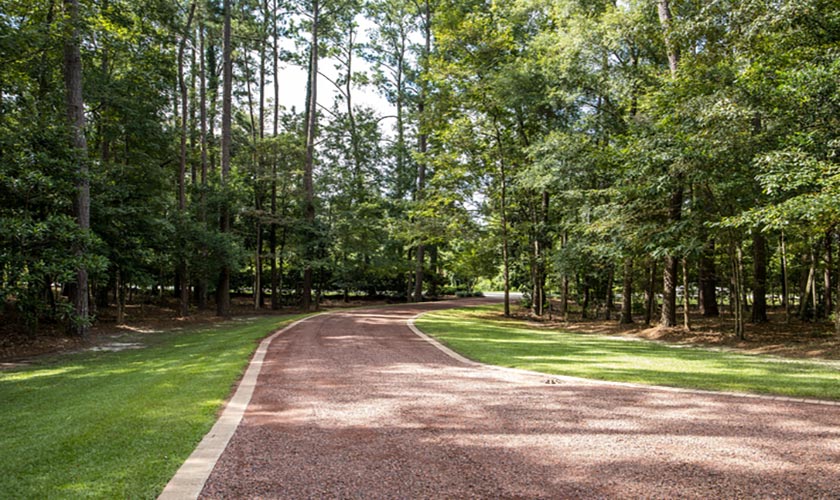
Which Gravel Driveway Edging Option Should You Choose?
Now that we’ve gone over most of the popular gravel driveway edging options, it can be challenging to decide which one is best for you. When making your decision, there are three main things to consider:
- Environment
- House design
- Personal preference
The environment should play a significant role in your decision as you don’t want to use an unideal material that will degrade or cause problems. In humid climates, it’s best to steer away from using timber as an edging material as it is more likely to rot and deteriorate over time. Additionally, you might want to avoid using vegetation or metal in hot climates as plants have a more challenging time surviving, and metal can heat up and reflect light.
You also want to consider your home’s style and any design elements that make a big impact when you first see your home. You should choose a driveway edging material that compliments your home’s materials. That isn’t to say you must use brick if your home’s exterior is brick, but it’s a good rule of thumb to use similar or complementary materials.
And last but not least are your personal preferences. The driveway on most house designs is quite prominent, so you want to choose an edging design and material that you like and one that will increase curb appeal.
Frequently Asked Questions
How do I keep my gravel from moving on my driveway?
Tips to keep gravel in place on driveways:
- Be sure your gravel is at least 4 inches thick. Be sure to evenly spread and pack the driveway well. Use a plow blade to evenly spread and pack the driveway.
- Don’t add sand under the driveway. It is ineffective at keeping gravel in place and causes gravel to embed itself in the sand and form ruts when driving on it after heavy rain.
- Install a border along the outer driveway edges to contain the gravel along the side of the driveway.
Do I need edging around gravel?
Gravel shifts and moves frequently, so it needs an edging along the border to keep it in place. Gravel driveway edging doesn’t have to be expensive. The edging should be about 3 to 4 inches high and the gravel shouldn’t spill over the edging.
Can you sprinkle cement over gravel?
It’s not necessary to pour cement over gravel and can actually do more harm to the gravel driveway. Pouring cement over gravel will likely have many thin areas which will be prone to crack easily. You won’t be able to use a scraper blade to spread the gravel to even it out because the cement will bind the gravel slag in large clumps.
Do I need fabric under the gravel driveway?
Yes, it’s best practice to lay landscape fabric over the ground before spreading the gravel. Without a fabric barrier, the gravel slag will eventually embed into the ground from heavy rain and vehicle traffic. Landscape fabric allows for water drainage while preventing weed growth and reducing gravel movement.
How many inches deep should a gravel driveway be?
The initial layer should be a larger slag gravel layer that is 4 inches deep. The second layer should also be 4 inches thick but in slightly smaller stones. All subsequent layers should be 4 inches thick and made up of progressively smaller stones. This serves to compact the driveway and create a solid surface that can last for many years.
Should I put sand under gravel?
We don’t recommend you add sand beneath the gravel driveway. The gravel will embed into the sand and can cause muddy ruts to form when driving on it after heavy rain.
How much gravel do I need for a 200-foot driveway?
For every 50 feet of a gravel driveway, you will need about 8 tons of gravel, spread 4-inches deep.
- A 100-foot driveway will need about 16 tons of gravel
- A 150-foot driveway will need about 24 tons of gravel
- A 200-foot driveway will need about 32 tons of gravel
- A 250-foot driveway will need about 40 tons of gravel
- A 300-foot driveway will need about 48 tons of gravel


